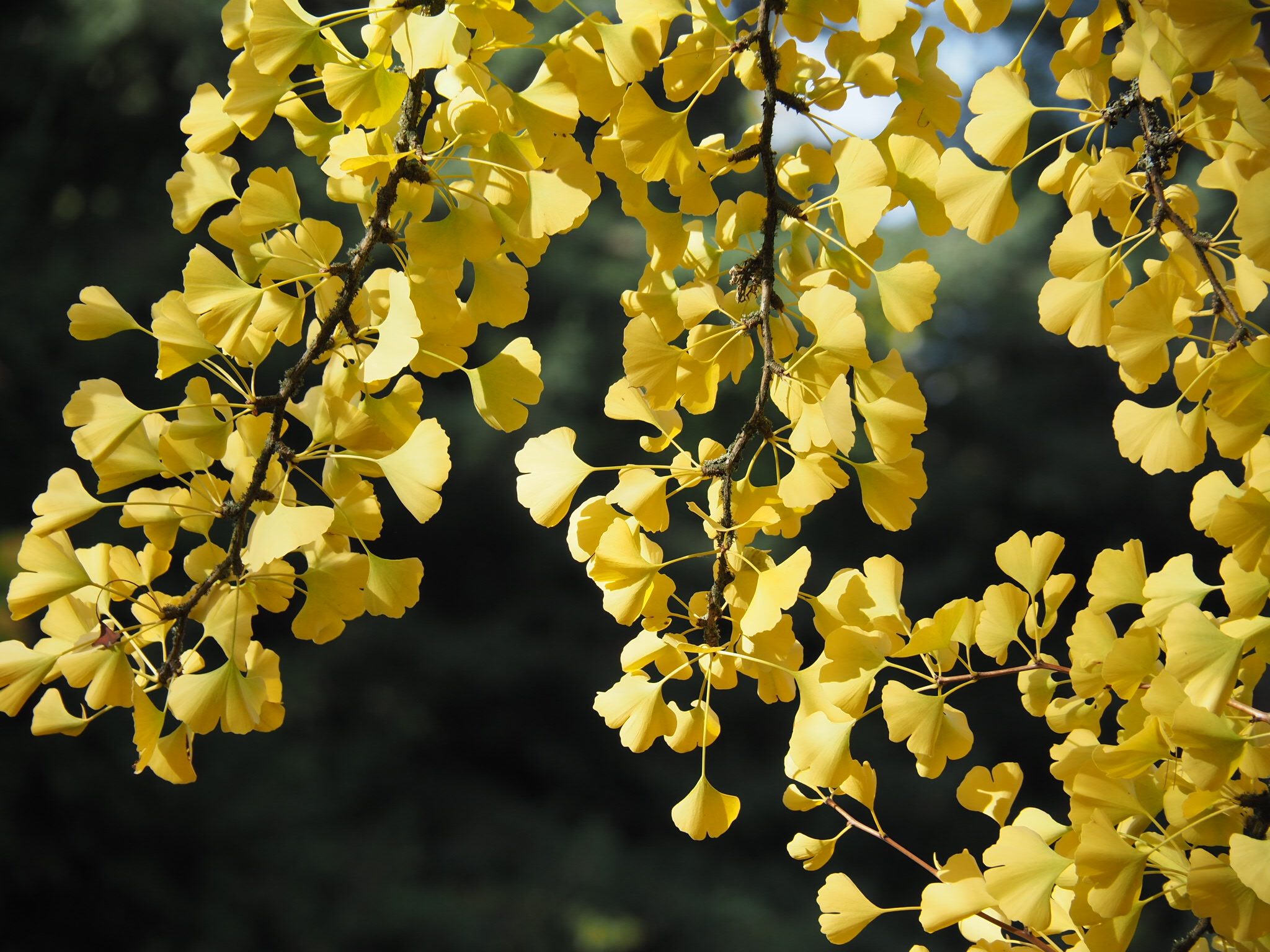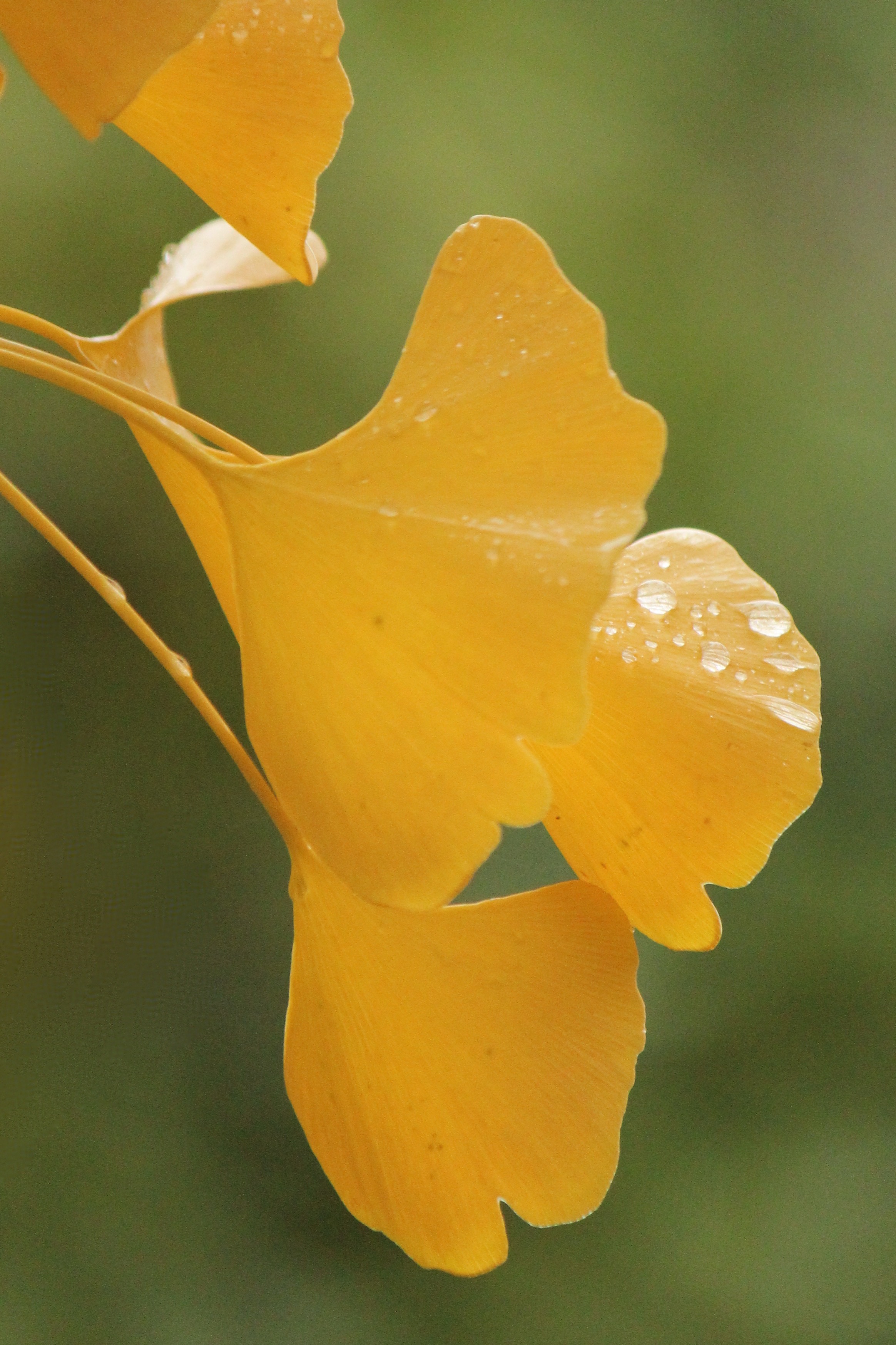Ginkgo's Story, Part Two: A Tree Renowned for Its Beauty & Usefulness
By Corinne Kennedy
Ginkgo branches in autumn (photo by Chie Iida, 2017)
Part One of this series dealt with the evolutionary history and botanical characteristics of Ginkgo biloba. A “living fossil,” its history reaches back over 200 million years. Prominent throughout the temperate world in the age of dinosaurs, ginkgo lost most of its range when the climate changed. However, people were attracted to this unique tree and began cultivating it about 1000 years ago, saving it from near extinction. This second of two articles examines ginkgo’s historical uses, cultural meanings, and the growing conditions it requires.
In China – and later, Korea and Japan – ginkgo was originally valued for the edibility of its seeds. Their foul-smelling coating was removed, and the nutlike kernel that remained was soaked and/or roasted. This process reduced the concentration of a toxin present in the raw seeds. They were eaten plain -- or used in sweet as well as savory dishes – and remain a popular food in eastern Asia. Ginkgo seeds, and products derived from them, were also used as oils for lighting & heating, in rituals, and in traditional medicine. Compounds from the seeds were used to treat cavities, skin conditions and respiratory illnesses. Even in the present day, ginkgo compounds are used to treat coughs, asthma and bladder infections.
(Mary Ann Cahill)
Very different medicinal uses – derived from the leaves rather than the seeds – were developed in the West. Ginkgo leaves contain many flavonoids (chemicals responsible for the colorful pigments in plant parts and believed to protect against pathogens and disease). A leaf extract was prescribed to treat blood flow issues, including age-related problems of concentration and memory. Such extracts continue to be popular, especially in Europe, despite conventional/allopathic medicine’s doubts about their efficacy.
Ginkgo biloba is particularly important in the cultures of China, Korea and Japan, where the oldest specimens of this long-lived tree are located.Large European specimens were planted less than 300 years ago, but there is strong evidence that some ginkgos in China are more than 1000 years old.Religions in all three countries viewed ginkgo as a sacred tree and a symbol of resilience, health and longevity.A cultural icon, it is also associated with hope and fertility.
The “T” that symbolizes the prefecture of Tokyo resembles a ginkgo leaf.
In addition to the importance of its seeds, ginkgo’s fan-shaped leaf is beautiful and unique, and lends itself to stylization. In eastern Asia, it became a recognizable motif. This motif was especially important in Japan, where it emerged in paintings and poetry, and in the designs of family crests (kamon). By the 17th century, it appeared on swords and ceramics -- and later, on buckles, jewelry, kimono and other textiles. More subtle examples abound. The tool used to pluck the strings of the shamisen (a traditional musical instrument) is shaped like a ginkgo leaf, as are the topknots (oichomage) of sumo wrestlers. Even the “T” that symbolizes the prefecture of Tokyo resembles a stylized ginkgo leaf.
Art Nouveau façade of Prague’s Hotel Central, featuring ginkgo leaves & seeds (Jorge Royan, 2014/ Wikimedia Commons)
Representations of ginkgo leaves also figure prominently in the art and architecture of the West. They appeared on vases, art tiles and other products of the early 20th century Arts & Crafts movement – and remain popular in the decorative arts of our own century.
“… many contemporary products… incorporate the ginkgo leaf motif. Its elegance and clean curves connect easily to an aesthetic that began as a reaction against the machine. Ginkgo was also taken up in Art Nouveau; there are spectacular renderings of ginkgo twigs and leaves in the Art Nouveau architecture of Nancy and Prague.”
Within the last 200 years, ginkgo trees have been grown successfully under a wide range of climatic and soil conditions. Outside of Asia, however, they are grown primarily as ornamentals. Males are preferred, because they rarely (and then only in very small numbers) produce the malodorous seeds characteristic of female trees. Propagated from cuttings to ensure maleness, they are planted in public and private gardens throughout the temperate world.
Most authorities list Ginkgo biloba as hardy to USDA Zone 3 (minimum temperature -30 to -40 degrees F.). It grows best in full sun with regular moisture, but adapts to part shade and any fertile, well-drained soil. It produces chemicals that deter insects, and is also resistant to damage by bacteria, viruses and fungi. In the cool climate of the Pacific Northwest, ginkgo is remarkably drought-tolerant.
Survivors, ginkgos are deep-rooted and tolerant of adverse conditions – including wind, pollution and fire. Ginkgo trees survived the 1923 Kanto earthquake and the 1945 atomic attack on Hiroshima. Several trees were less than 1½ miles from the epicenter. Their bark was scorched and their branches stripped away. A nearby temple was destroyed. Incredibly, the ginkgo trees survived and leafed out the following spring. Because of this toughness and adaptability, ginkgos succeed under difficult urban conditions and are commonly planted as street trees -- including here in Seattle. They make up about 11% of the street trees in Japan.
The genus Ginkgo is a living link between the lower and higher plants. Ginkgo biloba, the only remaining species, is a deciduous tree characterized by large seeds, long life, and endurance over millions of years. We’re fortunate to have three tall, elegant specimens in the Seattle Japanese Garden. They bring to the garden ancient history, uniquely beautiful leaves, glowing fall color, and a reminder of the brevity of human life on our planet.
Corinne Kennedy is a Garden Guide, frequent contributor to the Seattle Japanese Garden blog, and retired garden designer.




